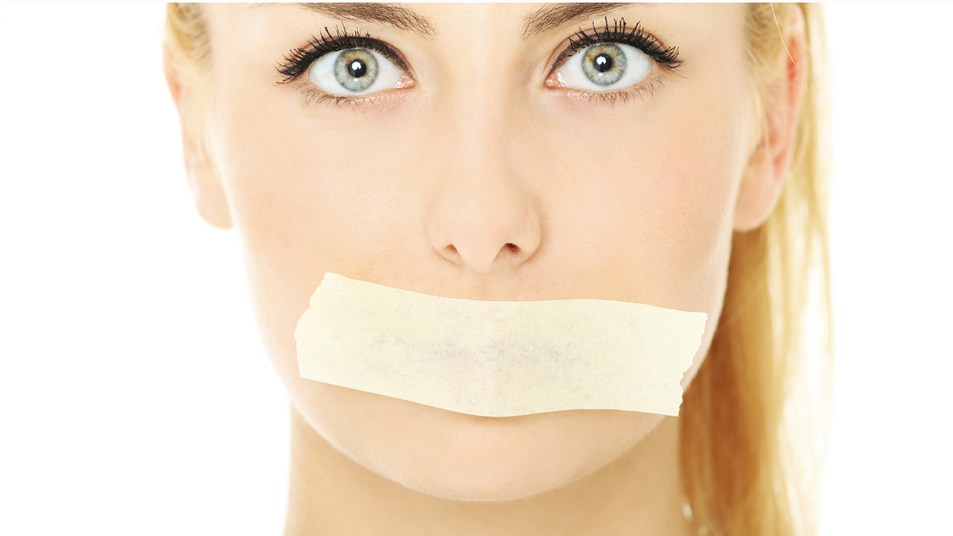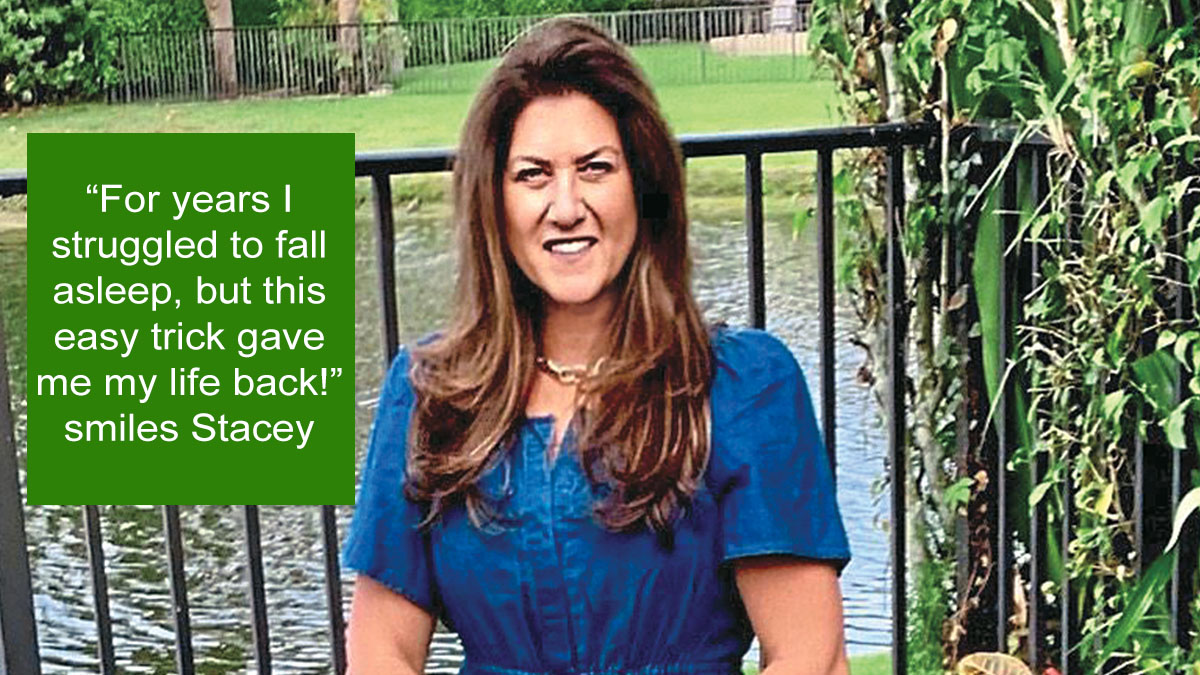A Growing Number of Experts Advocate Using Mouth Tape to Improve Sleep — One Woman’s Surprising Experience
It can dramatically improve snoring for good...in just three nights!

Stacey Shapiro lay awake, staring at the ceiling as the early morning hours ticked by, and knowing in her heart it was time for a change. For years, the 51-year-old had struggled with insomnia, which made it hard for her to fall asleep. And when she was finally able to close her eyes, she would awaken several times throughout the night, never able to get a full night’s rest or actually feel rested when she woke up.
Slogging through her days, Stacey struggled with severe fatigue from sleep disruption, which made doing pretty much anything, from work to home life, much more difficult. I can’t handle much more of this, she thought one day as the afternoon slump hit hard and she could barely keep her eyes open. Wary of prescription options for her sleep issues, Stacey decided to first go in search of a natural cure.
She had heard melotonin and valerian root could help soothe sleep troubles, so she bought some to try and gave them a few weeks to kick in…but still, her insomnia persisted. Is there anything I can do to fix this? she wondered, desperate for an answer. Or am I just going to spend the rest of my life feeling exhausted?
One day, while discussing her persistent sleep troubles with her cousin over lunch, Stacey learned about something she had never heard of before, and that her cousin insisted might finally fix her issues: mouth tape for sleep.

Is using mouth tape for sleep safe?
“That sounds so bizarre!” the Florida denizen laughed—after all, mouth tape was exactly what it sounded like. The technique involves placing a piece of soft porous tape vertically across your lips before you climb into bed, with the aim to reduce mouth-breathing and the snoring that comes alongside it. But as her cousin delved into how mouth tape for sleep worked and the potential benefits, the concept actually sounded more and more intriguing to Stacey.
The premise, Stacey discovered, is that taping your mouth while you sleep shut forces you to breathe through your nose, and this simple transition can benefit your sleep by increasing nitric oxide, a substance produced in the nasal passages that revs oxygen delivery to the lungs and circulation, while decreasing stress and anxiety.
How does mouth tape help you sleep?
Thinking over everything she’d learned, Stacey began to feel excited. “It all makes sense,” Stacey mused. “I’m simply going to change the path my breathing takes—from my mouth to my nose—and finally get a good’s night sleep.” Feeling as though she had nothing to lose by trying mouth tape, Stacey first checked with her doctor to make sure she didn’t have any conditions (like nasal polyps, a deviated septum, allergies or anything that would impair nasal breathing) that would disqualify her from giving it try.
But once she got the go-ahead, she bought Hostage Mouth Tape online and when they arrived, she was heartened to find the strips were less like actual tape and more like a breathable piece of fabric that was safe and comfortable for her skin—almost like a sleep mask for your mouth.
What does sleeping with mouth tape feel like?
Though wearing it felt a little odd at first, soon enough, Stacey was happily surprised to be drifting off to sleep. And when she awoke from her first night of mouth taping, she was shocked: instead of waking several times during the night, she had only woken up once.
“The mouth tape was comfortable, though the sensation of not breathing through my mouth as I fell asleep did feel a little unnatural at first,” Stacey describes of her first time using mouth tape. “But once I realized that I already knew how to breathe through my nose, it became completely normal.”
Does mouth tape for sleep really work?
Stacey kept wearing her mouth tape to sleep every night, and each evening, she was able to fall asleep fast—and stay asleep throughout the night. “These days, I wear my tape every night and I sleep better than I ever have! I feel well-rested in the morning, have more energy throughout the day and also have less anxiety about sleep—I know that when I go to sleep at night, I’m actually going to sleep well!”
A Doctor Weighs in On Using Mouth Tape For Sleep
More than 70% of women experience fatigue because they breathe through their mouth rather than their nose. Mouth-breathing deprives the body of nitric oxide, a substance produced in nasal passages that helps to increase oxygen delivery to the lungs by widening blood vessels, explains Ron Sinha, MD, an internal medicine specialist based in Palo Alto, California. “So by breathing through your mouth, you’re limiting deliver of oxygen to your lungs—and your breathing becomes faster and more shallow to compensate.” This causes carbon dioxide levels to drop, raising blood pH levels and preventing oxygen from being released as easily to your body’s tissues, he notes. During the day, mouth breathing can trigger tiredness, brain fog , anxiety and other draining symptoms—and at night, it raises risks of snoring and sleep apnea that make exhaustion worse.
But mouth taping can decrease snoring by 64% within three nights, suggests research in Otolaryngology—Head & Neck Surgery. In the study, patients with sleep apnea gently sealed their lips closed at night and found that the strategy stabilized their upper airways to reduce snoring severity and frequency, plus ease sleep apnea. Folks in the study used a silicone patch, but Dr. Sinha., advises applying a strip of porous skin-safe surgical tape (like 3M Micropore Surgical Tape) across your mouth before bed. (Click through to learn how CBD oil can help with sleep.)
“Use just enough to keep your lips closed and experiment during the day to find what’s most comfortable,” he says. “For many of my patients, mouth taping has been a game changer in terms of enhancing sleep.” He also notes to be sure to check with your healthcare provider first, since people with conditions that impair nasal breathing may not be candidates for mouth taping. (Click through to learn more about using mouth tape to stop snoring.)
Other Benefits of Mouth Taping
What’s more, using mouth tape to encourage nose-breathing can bring on many more benefits than just a great night’s rest! Here’s a few other things it can help with:
Improved digestion: Taking just a few seconds to perform a simple pre-meal breathing exercise through the nose activates the parasympathetic nervous system to improve digestion and nutrient absorption, asserts Steven Lin, D.D.S., author of The Dental Diet. To do: Take five deep breaths through your nose, inhaling for three counts and exhaling for two. Bonus: Breathing through the nose improves saliva output, says Dr. Lin, which, in turn, keeps bad oral bacteria (that can put you at risk for heart disease and diabetes) in check.
Wards off illness: The compound nitric oxide released by your sinuses during nose breathing travels deep into your lungs, blocking the growth of viruses and bacteria, opening airways and improving blood circulation to the lungs to boost oxygen absorption by 20%. Ear, nose and throat specialist Len Zhang, M.D., adds that inhaling this way makes breathing easier, whether you have allergies, bronchitis or a serious lung infection.
Boosts brainpower: Stanford University researchers say nasal breathing boosts oxygen flow to the brain by 20%, triggering instant calm. What’s more, the scientists found that breathing through your nose synchronizes electrical activity in the amygdala and hippocampus parts of the brain to supercharge brain function, including focus and the ability to learn new information.
For more on mouth tape:
For Certain Snorers, Mouth Taping Could Provide an Alternative to CPAP Machines
The Truth About Mouth Taping — and Other Wacky Folk Remedies, According to an MD
This content is not a substitute for professional medical advice or diagnosis. Always consult your physician before pursuing any treatment plan.













